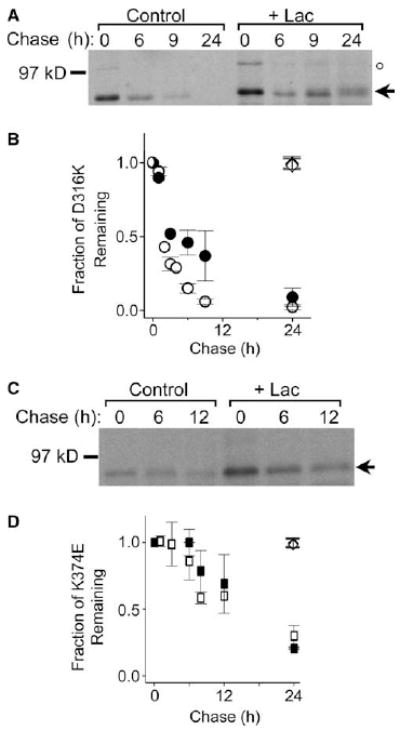Fig. 1.

Degradation of D316K and K374E mutant proteins is differentially sensitive to lactacystin. (A,C) D316K and K374E were expressed in HEK293T cells, metabolically labeled, and chased for the indicated times in the absence or presence of the proteasomal inhibitor, lactacystin (Lac, 10 μM). Following solubilization, Shaker proteins were immunoprecipitated and subjected to electrophoresis and fluorography. Representative fluorographs for D316K (A) and K374E (C) are shown. The arrow indicates the position of the immature, core-glycosylated mutant protein. In addition to the immature band, a sharp band with an apparent molecular weight of 100 kDa is visible in (A) immediately after the pulse and then disappears rapidly thereafter (position denoted by ○). The same unstable band is seen immediately after the pulse upon expression of the wild-type protein; the band is degraded in the interval before substantial maturation of the wild-type protein occurs (see Fig. 3 in [27]). The identity of this band has not been determined. It does not correspond to the mature form of Shaker, which migrates as a broad band exhibiting high stability [27,30]. It was not included in any of the calculations described in this paper. (B,D) Summary of densitometric analysis of the turnover of the immature Shaker protein for (B) D316K (open circles, n = 8) and D316K + Lac (filled circles, n = 5), and (D) K374E (open squares, n = 4–6) and K374E + Lac (filled squares, n = 3). The amount of protein in the immature band was quantified by densitometry, normalized to the amount of Shaker protein at time 0, and plotted versus chase time. Unless otherwise stated, the data in this and subsequent figures are provided as means ± S.E.M. For the D316K mutant, the half time of degradation (t1/2) was estimated to be 2 h in the absence and 4.4 h in the presence of Lac. The t1/2 for the K374E mutant was estimated to be 15 h in the absence and 17 h in the presence of Lac. For comparison, at 24 h ~98% of the wild-type Shaker protein remained either in the absence (open diamonds, n = 14) or presence (filled diamonds, n = 4) of Lac [30].
